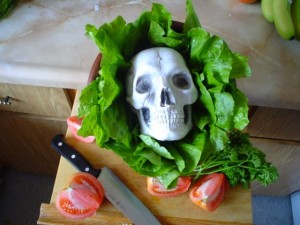Lettuce is overrated.
 That’s my response to people who ask about the proportionally high rates of foodborne illness in lettuce and other leafy greens eaten raw.
That’s my response to people who ask about the proportionally high rates of foodborne illness in lettuce and other leafy greens eaten raw.
I like spinach – in a lasagna or stir-fry – but not raw.
Raw is risky.
There’s a bunch of new findings on foodborne pathogens and leafy greens which are summarized below.
In the sphere of public conversation, it is notable the Leafy Greens Marketing Agreement, the group formed after the 2006 E. coli-in-spinach outbreak that killed four and sickened at least 200 in the U.S. – has been once again silent on any research or outbreaks that associate risk with greens.
The leafy green cone of silence.
Investigations by University of Leicester microbiologists have revealed that just a small amount of damage to salad leaves can massively stimulate the presence of the food Salmonella in ready-prepared salad leaves.
The scientists have discovered that juices released from damaged leaves also had the effect of enhancing the virulence of the pathogen, potentially increasing its ability to cause infection in the consumer.
The research is led by Dr Primrose Freestone of the University’s Department of Infection, Immunity and Inflammation and PhD student Giannis Koukkidis, who has been funded by a Biotechnology and Biological Sciences Research Council (BBSRC) i-case Studentship.
Their research investigates novel methods of preventing food poisoning pathogens from attaching to the surface of salad leaves to help producers improve food safety for consumers.
This latest study, published in Applied and Environmental Microbiology, found that juices from damaged leaves in bagged spinach and mixed salad increased Salmonella pathogen growth 2400-fold over a control group and also enhanced their adherence to surfaces and overall virulence, or capacity to cause disease.
Dr Freestone said: “Salad leaves are cut during harvesting and we found that even microliters of the juices (less than 1/200th of a teaspoon) which leach from the cut-ends of the leaves enabled Salmonella to grow in water, even when it was refrigerated. These juices also helped the Salmonella to attach itself to the salad leaves so strongly that vigorous washing could not remove the bacteria, and even enabled the pathogen to attach to the salad bag container.
“This strongly emphasizes the need for salad leaf growers to maintain high food safety standards as even a few Salmonella cells in a salad bag at the time of purchase could become many thousands by the time a bag of salad leaves reaches its use by date, even if kept refrigerated. Even small traces of juices released from damaged leaves can make the pathogen grow better and become more able to cause disease.
“It also serves as a reminder to consume a bagged salad as soon as possible after it is opened. We found that once opened, the bacteria naturally present on the leaves also grew much faster even when kept cold in the fridge.
“This research did not look for evidence of Salmonella in bagged salads. Instead, it examined how Salmonella grows on salad leaves when they are damaged.”
Leafy green and other salad vegetables are an important part of a healthy diet, providing vitamins, minerals, and dietary fiber. Ready to eat prepared salads are particularly popular, are widely consumed and so of significant economic importance. Over recent years there has however been a number of outbreaks associated with fresh salad produce contaminated with Salmonella and E. coli both in the USA and Europe.
 This has triggered considerable interest in effective strategies for controls and interventions measures both in UK industry, the EU and key research funding bodies.
This has triggered considerable interest in effective strategies for controls and interventions measures both in UK industry, the EU and key research funding bodies.
Despite a number of published reports on improving the microbiological safety of salad leaf production, very few studies have investigated the behavior of Salmonella once the leaves have been bagged.
Giannis said: “Anything which enhances adherence of foodborne pathogens to leaf surfaces also increases their persistence and ability to resist removal, such as during salad washing procedures. Even more worrying for those who might eat a Salmonella contaminated salad was the finding that proteins required for the virulence (capacity to cause infection) of the bacteria were increased when the Salmonella came into contact with the salad leaf juices. “Preventing enteric pathogen contamination of fresh salad produce would not only reassure consumers but will also benefit the economy due to fewer days lost through food poisoning. We are now working hard to find ways of preventing salad-based infections.”
No comment from the LGMA.
While this research may make it seem like pre-packaged salads pose a scary risk, the researchers themselves were quick to say they still eat bagged salads. But they make sure to look for packages that have appropriate use-by dates and crisp-looking leaves. They stay away from salads that have mushy, slimy-looking greens, or bags with accumulated salad juice at the bottom. And they make sure to eat the greens within one day of purchase.
“Our project does not indicate any increased risk to eating leafy salads, but it does provide a better understanding of the factors contributing to food poisoning risks,” said Freestone.
If you feel like it, you can wash greens that have already been pre-washed by manufacturers just before eating, but Freestone says this doesn’t have much of an effect on the salmonella bacteria that may already be attached or internalized by the leaves.
Her study was published in the journal Applied and Environmental Microbiology.
No comment from LGMA.
Assessment of irrigation water quality and microbiological safety of leafy greens in different production systems
Journal of Food Safety, 2 November 2016, DOI: 10.1111/jfs.12324
Foodborne disease outbreaks associated with fresh produce irrigated with contaminated water are a constant threat to consumer health. In this study, the impact of irrigation water on product safety from different food production systems (commercial to small-scale faming and homestead gardens) was assessed.
 Hygiene indicators (total coliforms, Escherichia coli), and selected foodborne pathogens (Salmonella spp., Listeria monocytogenes, and Escherichia coli O157:H7) of water and leafy green vegetables were analyzed. Microbiological parameters of all irrigation water (except borehole) exceeded maximum limits set by the Department of Water Affairs for safe irrigation water. Microbial parameters for leafy greens ranged from 2.94 to 4.31 log CFU/g (aerobic plate counts) and 1 to 5.27 log MPN/100g (total coliforms and E. coli). Salmonella and E. coli O157:H7 were not detected in all samples tested but L. monocytogenes was present in irrigation water (commercial and small-scale farm, and homestead gardens).
Hygiene indicators (total coliforms, Escherichia coli), and selected foodborne pathogens (Salmonella spp., Listeria monocytogenes, and Escherichia coli O157:H7) of water and leafy green vegetables were analyzed. Microbiological parameters of all irrigation water (except borehole) exceeded maximum limits set by the Department of Water Affairs for safe irrigation water. Microbial parameters for leafy greens ranged from 2.94 to 4.31 log CFU/g (aerobic plate counts) and 1 to 5.27 log MPN/100g (total coliforms and E. coli). Salmonella and E. coli O157:H7 were not detected in all samples tested but L. monocytogenes was present in irrigation water (commercial and small-scale farm, and homestead gardens).
This study highlights the potential riskiness of using polluted water for crop production in different agricultural settings.
No comment from LGMA.
Adaptive response of Listeria monocytogenes to heat, salinity and low pH, after habituation on cherry tomatoes and lettuce leaves
PLOS
Sofia V. Poimenidou, Danai-Natalia Chatzithoma, George-John Nychas, Panagiotis N. Skandamis
http://journals.plos.org/plosone/article?id=10.1371/journal.pone.0165746
Pathogens found on fresh produce may encounter low temperatures, high acidity and limited nutrient availability. The aim of this study was to evaluate the effect of habituation of Listeria monocytogenes on cherry tomatoes or lettuce leaves on its subsequent response to inhibitory levels of acid, osmotic and heat stress.
Habituation was performed by inoculating lettuce coupons, whole cherry tomatoes or tryptic soy broth (TSB) with a three-strains composite of L. monocytogenes, which were further incubated at 5°C for 24 hours or 5 days. Additionally, cells grown overnight in TSB supplemented with 0.6% yeast extract (TSBYE) at 30°C were used as control cells. Following habituation, L. monocytogenes cells were harvested and exposed to: (i) pH 3.5 adjusted with lactic acid, acetic acid or hydrochloric acid (HCl), and pH 1.5 (HCl) for 6 h; (ii) 20% NaCl and (iii) 60°C for 150 s.
Results showed that tomato-habituated L. monocytogenes cells were more tolerant (P < 0.05) to acid or osmotic stress than those habituated on lettuce, and habituation on both foods resulted in more stress resistant cells than prior growth in TSB. On the contrary, the highest resistance to heat stress (P < 0.05) was exhibited by the lettuce-habituated L. monocytogenes cells followed by TSB-grown cells at 5°C for 24 h, whereas tomato-habituated cells were highly sensitized. Prolonged starvation on fresh produce (5 days vs. 24 h) increased resistance to osmotic and acid stress, but reduced thermotolerance, regardless of the pre-exposure environment (i.e., tomatoes, lettuce or TSB).
 These results indicate that L. monocytogenes cells habituated on fresh produce at low temperatures might acquire resistance to subsequent antimicrobial treatments raising important food safety implications.
These results indicate that L. monocytogenes cells habituated on fresh produce at low temperatures might acquire resistance to subsequent antimicrobial treatments raising important food safety implications.
No comment from LGMA.
Efficacy of post-harvest rinsing and bleach disinfection of E. coli O157:H7 on spinach leaf surfaces
Food Microbiology, April 2017, vol 62, pg 212-220, http://dx.doi.org/10.1016/j.fm.2016.10.019
Attachment and detachment kinetics of Escherichia coli O157:H7 from baby spinach leaf epicuticle layers were investigated using a parallel plate flow chamber. Mass transfer rate coefficients were used to determine the impact of water chemistry and common bleach disinfection rinses on the removal and inactivation of the pathogen. Attachment mass transfer rate coefficients generally increased with ionic strength. Detachment mass transfer rate coefficients were nearly the same in KCl and AGW rinses; however, the detachment phase lasted longer in KCl than AGW (18 ± 4 min and 4 ± 2 min, respectively), indicating that the ions present during attachment play a significant role in the cells’ ability to remain attached. Specifically, increasing bleach rinse concentration by two orders of magnitude was found to increase the detachment mass transfer rate coefficient by 20 times (from 5.7 ± 0.7 × 10−11 m/s to 112.1 ± 26.8 × 10−11 m/s for 10 ppb and 1000 ppb, respectively), and up to 88 ± 4% of attached cells remained alive.
 The spinach leaf texture was incorporated within a COMSOL model of disinfectant concentration gradients, which revealed nearly 15% of the leaf surface is exposed to almost 1000 times lower concentration than the bulk rinse solution.
The spinach leaf texture was incorporated within a COMSOL model of disinfectant concentration gradients, which revealed nearly 15% of the leaf surface is exposed to almost 1000 times lower concentration than the bulk rinse solution.
No comment from LGMA.
Development of growth and survival models for Salmonella and Listeria monocytogenes during non-isothermal time-temperature profiles in leafy greens
Food Control, Vol 71, Part A, Jan 2017, Pg 32-41
http://dx.doi.org/10.1016/j.foodcont.2016.06.009
http://www.sciencedirect.com/science/article/pii/S0956713516303164
Leafy greens contaminated with Salmonella enterica have been linked to large number of illnesses in many countries in recent years. Listeria monocytogenes is also a pathogen of concern for leafy greens because of its prevalence in the growing and processing environment and its ability to grow at refrigeration temperatures. Experimental data for the growth and survival of S. enterica and L. monocytogenes under different conditions and storage temperatures were retrieved from published studies. Predictive models were developed using the three-phase linear model as a primary growth model and square-root model to calculate specific growth rate (ln CFU g−1 h−1) at different temperatures (°C). The square-root model for S. enterica was calculated as μ = (0.020(Temperature+0.57))2. The square-root model for L. monocytogenes was fitted as μ = (0.023(Temperature-0.60))2. The growth-survival model for S. enterica and growth model for L. monocytogenes were validated using several dynamic time-temperature profiles during the production and supply chain of leafy greens. The models from this study will be useful for future microbial risk assessments and predictions of behavior of S. enterica and L. monocytogenes in the leafy greens production and supply chain.
No comment from LGMA.
Is there a relation between the microscopic leaf morphology and the association of Salmonella and Escherichia coli O157:H7 with iceberg lettuce leaves?
Journal of Food Protection, Number 10, October 2016, pp. 1656-1662, pp. 1784-1788(5)
I Van der Linden, M Eriksson, M Uyttendaele, F Devlieghere
http://www.ingentaconnect.com/content/iafp/jfp/2016/00000079/00000010/art00017
To prevent contamination of fresh produce with enteric pathogens, more insight into mechanisms that may influence the association of these pathogens with fresh produce is needed.
 In this study, Escherichia coli O157:H7 and Salmonella were chosen as model pathogens, and fresh cut iceberg lettuce was chosen as a model fresh produce type. The morphological structure of iceberg lettuce leaves (stomatal density and length of cell margins per leaf area) was quantified by means of leaf peels and light microscopy of leaves at different stages of development (outer, middle, and inner leaves of the crop) on both leaf sides (abaxial and adxial) and in three leaf regions (top, center, and bottom). The morphology of the top region of the leaves was distinctly different from that of the center and base, with a significantly higher stomatal density (up to five times more stomata), different cell shape, and longer cell margins (two to three times longer). Morphological differences between the same regions of the leaves at different stages of development were smaller or nonsignificant. An attachment assay with two attenuated E. coli O157:H7 strains (84-24h11-GFP and BRMSID 188 GFP) and two Salmonella strains (serovars Thompson and Typhimurium) was performed on different regions of the middle leaves. Our results confirmed earlier reports that these pathogens have a higher affinity for the base of the lettuce leaf than the top. Differences of up to 2.12 log CFU/g were seen (E. coli O157:H7 86-24h11GFP). Intermediate attachment occurred in the central region.
In this study, Escherichia coli O157:H7 and Salmonella were chosen as model pathogens, and fresh cut iceberg lettuce was chosen as a model fresh produce type. The morphological structure of iceberg lettuce leaves (stomatal density and length of cell margins per leaf area) was quantified by means of leaf peels and light microscopy of leaves at different stages of development (outer, middle, and inner leaves of the crop) on both leaf sides (abaxial and adxial) and in three leaf regions (top, center, and bottom). The morphology of the top region of the leaves was distinctly different from that of the center and base, with a significantly higher stomatal density (up to five times more stomata), different cell shape, and longer cell margins (two to three times longer). Morphological differences between the same regions of the leaves at different stages of development were smaller or nonsignificant. An attachment assay with two attenuated E. coli O157:H7 strains (84-24h11-GFP and BRMSID 188 GFP) and two Salmonella strains (serovars Thompson and Typhimurium) was performed on different regions of the middle leaves. Our results confirmed earlier reports that these pathogens have a higher affinity for the base of the lettuce leaf than the top. Differences of up to 2.12 log CFU/g were seen (E. coli O157:H7 86-24h11GFP). Intermediate attachment occurred in the central region.
The higher incidence of preferential bacterial attachment sites such as stomata and cell margins or grooves could not explain the differences observed in the association of the tested pathogens with different regions of iceberg lettuce leaves.
No comment from LGMA.
The N.Y Times reports the one place the one place the Salinas Valley’s bounty of antioxidants does not often appear is on the tables of the migrant workers who harvest it.
 More than a third of the children in the Salinas City Elementary School District are homeless; overall diabetes rates are rising and projected to soar; and 85 percent of farmworkers in the valley are overweight or obese, partly because unhealthy food is less costly, said Marc B. Schenker, a professor at the University of California, Davis, who studies the health of farmworkers.
More than a third of the children in the Salinas City Elementary School District are homeless; overall diabetes rates are rising and projected to soar; and 85 percent of farmworkers in the valley are overweight or obese, partly because unhealthy food is less costly, said Marc B. Schenker, a professor at the University of California, Davis, who studies the health of farmworkers.
No comment from LGMA.
Sponge Bob wants answers.





